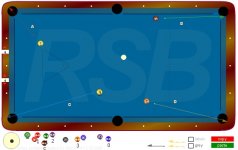JoeyA said:I was just wondering what most of you aimed at when attempting to pocket an object ball:
The contact point on the object ball.
The whole object ball.
Lights on the object ball.
The base of the object ball.
Thanks,
JoeyA
I think you will find methods for almost all you have listed above......(plus a few others that you did not think of)
Bottom line is you need to aim at (something)...The particular method you end up using will be the one your most comfortable with...
BTW...I would expect "SONIA" will be posting a reply to your post at some point...The post may or may not rub you the wrong way, but if you really are interested in Aiming Methods...I would suggest you follow up on the post.
